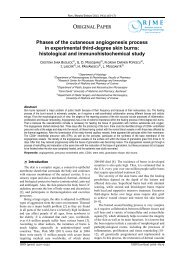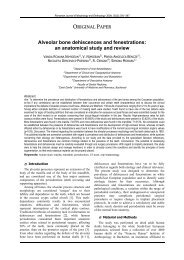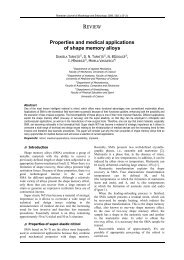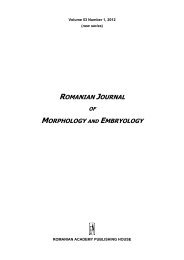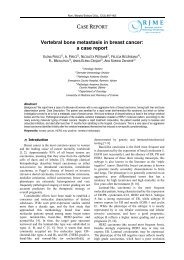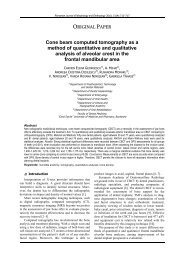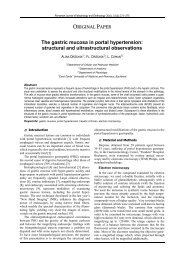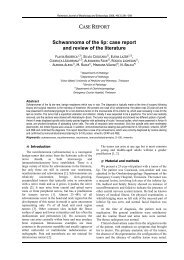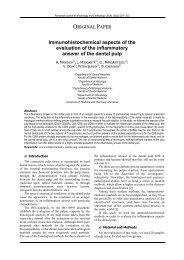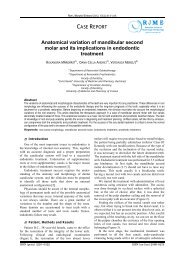Supratentorial pilocytic astrocytoma in children - RJME - Romanian ...
Supratentorial pilocytic astrocytoma in children - RJME - Romanian ...
Supratentorial pilocytic astrocytoma in children - RJME - Romanian ...
Create successful ePaper yourself
Turn your PDF publications into a flip-book with our unique Google optimized e-Paper software.
<strong>Romanian</strong> Journal of Morphology and Embryology 2010, 51(3):577–580<br />
CASE REPORT<br />
<strong>Supratentorial</strong> <strong>pilocytic</strong> <strong>astrocytoma</strong><br />
<strong>in</strong> <strong>children</strong><br />
CARMEN ELENA NICULESCU 1) , LIGIA STĂNESCU 1) ,<br />
M. POPESCU 2) , D. NICULESCU 3)<br />
1)<br />
Department of Pediatrics<br />
2)<br />
Department of Radiology<br />
3)<br />
Department of Orthopedic Surgery<br />
University of Medic<strong>in</strong>e and Pharmacy of Craiova<br />
Abstract<br />
Bra<strong>in</strong> tumors hold second place <strong>in</strong> tumoral pediatric pathology and have a complex etiopathogeny. The authors describe the case of a child<br />
aged 2 years and 4 months with <strong>in</strong>creased <strong>in</strong>tracranial pressure, symptomatology accompanied by rapid deterioration of general condition.<br />
Head CT imag<strong>in</strong>g exam<strong>in</strong>ation showed <strong>in</strong>tra-nevraxial replacement space process, supratentorial. Histopathological exam<strong>in</strong>ation revealed<br />
the typical grade I <strong>pilocytic</strong> <strong>astrocytoma</strong>. Time of diagnosis and surgical <strong>in</strong>tervention is essential for further evolution and prognosis.<br />
Keywords: <strong>pilocytic</strong> <strong>astrocytoma</strong>, supratentorial, <strong>in</strong>tracranial hypertension.<br />
� Introduction<br />
Bra<strong>in</strong> tumors comprise approximately 20% of all<br />
childhood malignancies, second <strong>in</strong> frequency only to<br />
acute lymphoblastic leukemia [1].<br />
Infratentorial bra<strong>in</strong> tumors prevail <strong>in</strong> <strong>children</strong> (60%),<br />
but <strong>in</strong> <strong>in</strong>fants and toddlers most of the tumors are supratentorial,<br />
like <strong>in</strong> adults [2]. The <strong>in</strong>cidents of bra<strong>in</strong> tumors<br />
have a cont<strong>in</strong>uous <strong>in</strong>creas<strong>in</strong>g rate <strong>in</strong> <strong>children</strong> on one<br />
hand because of many factors, which <strong>in</strong>fluence the nervous<br />
system development beg<strong>in</strong>n<strong>in</strong>g with the gestational<br />
period and on the other hand because of the means of<br />
complex exploration of central nervous system.<br />
All statistical data shows an <strong>in</strong>creased frequency of<br />
<strong>in</strong>tracranial tumors (ICT) <strong>in</strong> <strong>children</strong> correlated with<br />
repeated nuclear accidents, which have a major <strong>in</strong>fluence<br />
on neuroectodermal tissue development. Some genetic<br />
factors were also blamed: dysfunction of the p53<br />
tumor suppressor gene; the activation of some oncogenes.<br />
The connection between bra<strong>in</strong> tumors <strong>in</strong> <strong>children</strong><br />
and antipolio vacc<strong>in</strong>ation or rubella is known. The recent<br />
researches have proved that the malignant process<br />
appears on tissues which have suffered prior pathological<br />
changes: <strong>in</strong>flammatory, proliferative, dystrophic,<br />
irritation and traumatic.<br />
The characteristic feature of these previous lesions is<br />
the fact that they do not have the tendency to regress,<br />
but it is possible to transform <strong>in</strong> a certa<strong>in</strong> percentage <strong>in</strong><br />
<strong>in</strong>tracranial tumors, due to the <strong>in</strong>tervention of general or<br />
local factors, exogenous or endogenous. The male to<br />
female ratio is approximately 1:1, except for supratentorial<br />
low grade gliomas, <strong>in</strong> which case it is approximately<br />
2:1 [3]. From the histopathological po<strong>in</strong>t of view, neuroepitelial<br />
tissue tumors prevail.<br />
Astrocytoma is the most common bra<strong>in</strong> tumor,<br />
account<strong>in</strong>g for more than half of all primary central<br />
nervous system malignancies [4]. Researchers report<br />
that the annual <strong>in</strong>cidence is approximately 14 new cases<br />
per million <strong>in</strong> <strong>children</strong> under 15 years.<br />
Astrocytoma has neuroectodermal orig<strong>in</strong>s, from<br />
astrocytar nevroglia; it is classified <strong>in</strong> four categories<br />
depend<strong>in</strong>g on the grade of malignancy. Grade I <strong>astrocytoma</strong><br />
is a benign tumor that predom<strong>in</strong>antly arises <strong>in</strong><br />
<strong>in</strong>fratentorial locations such as the cerebellum and<br />
diencephalic region and rarely arises <strong>in</strong> supratentorial<br />
locations, <strong>in</strong> any hemispheric lobe, but especially <strong>in</strong> the<br />
frontal lobe [5].<br />
� Patient and Methods<br />
The authors describe the case of a child aged 2 years<br />
and 4 months, male, hospitalized <strong>in</strong> the No. I Pediatric<br />
Cl<strong>in</strong>ic of the Emergency County Hospital of Craiova <strong>in</strong><br />
December 2008. He was hospitalized for repeated vomit<strong>in</strong>g<br />
and acute dehydration syndrome, which had begun<br />
24 hours before the presentation. Cl<strong>in</strong>ical records po<strong>in</strong>ted<br />
out a ur<strong>in</strong>ary tract <strong>in</strong>fection with Proteus mirabilis<br />
three weeks prior. We performed the usual paracl<strong>in</strong>ic<br />
tests, funduscopic exam<strong>in</strong>ation, neuropsychiatric exam<strong>in</strong>ation,<br />
head CT scan and histopathologic exam<strong>in</strong>ation<br />
of the tumor.<br />
� Results<br />
In this case the cl<strong>in</strong>ical exam<strong>in</strong>ation performed on<br />
arrival revealed a non-feverish, conscious, cooperat<strong>in</strong>g<br />
child with average general status, with dry oral mucosa,<br />
reduced salivation, persistent abdom<strong>in</strong>al sk<strong>in</strong> fold; with<br />
moderate tachycardia; normal respiratory; with supple<br />
abdomen, sensitive to palpation; repeated vomit<strong>in</strong>g,<br />
“<strong>in</strong> jet”, conta<strong>in</strong><strong>in</strong>g food, subsequently liquids; with<br />
normal <strong>in</strong>test<strong>in</strong>al transit; without signs of men<strong>in</strong>geal<br />
irritation and without other neurological signs.
578<br />
Biological <strong>in</strong>vestigations have highlighted a moderate<br />
hypochromic anemia, a moderate leukocytosis<br />
(11700/cmm), hypocalcemia, normal sedimentation rate,<br />
acute phase reagents with normal values, all ur<strong>in</strong>ary<br />
tests with normal values. Surgical exam<strong>in</strong>ation ruled<br />
out acute abdomen. The patient was rebalanc<strong>in</strong>g<br />
from hydro-electrolytic and acido-basic po<strong>in</strong>t of view,<br />
with <strong>in</strong>itial favorable cl<strong>in</strong>ical evolution. Subsequently,<br />
the status of patient had deteriorated and the follow<strong>in</strong>g<br />
signs and symptoms came out: pavor night crises,<br />
psychomotor agitation alternat<strong>in</strong>g with drows<strong>in</strong>ess and<br />
lethargy, frontal headache, recurrence of vomit<strong>in</strong>g,<br />
<strong>in</strong>termittent convergent strabismus. Neuropsychiatric<br />
exam<strong>in</strong>ation additionally showed: palat<strong>in</strong>e wave<br />
deviated from the median l<strong>in</strong>e, pronounced hypotonia;<br />
normal osteo-tend<strong>in</strong>ous and abdom<strong>in</strong>al sk<strong>in</strong> reflexes;<br />
abnormal bilateral plantar reflex (positive bilateral<br />
Bab<strong>in</strong>ski sign); motility exam<strong>in</strong>ation – <strong>in</strong>ability to<br />
ma<strong>in</strong>ta<strong>in</strong> <strong>in</strong>dependent orthostatism; control over the<br />
head – present; discrete stiff neck; medium equal<br />
Carmen Elena Niculescu et al.<br />
pupils, reactive. A funduscopic exam<strong>in</strong>ation revealed<br />
papilledema.<br />
Head CT scan imag<strong>in</strong>g exam<strong>in</strong>ation showed: <strong>in</strong>tranevraxial<br />
space replacement process, supratentorial,<br />
heterogenous, developed <strong>in</strong> the left frontal region, with<br />
dimensions of 65/74 mm, with many lobes appearance,<br />
present<strong>in</strong>g anarchical vascularity, with central necrosis,<br />
with a parasagittal component adjo<strong>in</strong><strong>in</strong>g the scythe,<br />
present<strong>in</strong>g <strong>in</strong>fracortical development; adjo<strong>in</strong><strong>in</strong>g vasogenic<br />
edema and mass effect on ventricular structures<br />
with compression of the left ventricle; ventricular system<br />
displacement and engagement phenomena under<br />
bra<strong>in</strong> scythe. Tumoral process described determ<strong>in</strong>es<br />
secondary obstructive hydrocephaly, proof of this be<strong>in</strong>g<br />
transependimar periventricular edema, adjo<strong>in</strong><strong>in</strong>g the<br />
right lateral ventricle (Figures 1 and 2). The head CT<br />
scan computer reveals <strong>in</strong>tra-nevraxial space replacement<br />
process, supratentorial, with astroglial orig<strong>in</strong> probably.<br />
A possible xantocytoma cannot be excluded. Also, one<br />
can observe the secondary obstructive hydrocephaly.<br />
Figure 1 – P1–P3 (CT axial native sections) – heterogenous, supratentorial, nevraxial space replacement process, left<br />
temporo-frontal developed, bulky and hypodense, without significant cyst elements, adjo<strong>in</strong><strong>in</strong>g vasogenic edema and<br />
mass effect on ventricular structures with compression of the left ventricle; secondary obstructive hydrocephaly, proof<br />
of this be<strong>in</strong>g transependymar periventricular edema, adjo<strong>in</strong><strong>in</strong>g the right lateral ventricle.<br />
Figure 2 – P1–P4 (CT axial native postcontrast sections) – heterogenous matrix of the tumoral mass, with anarchical<br />
vascularity and central necrosis; the tumor’s limits are more evident and the bra<strong>in</strong> vessels are deviated to the right; the<br />
transependymar hypodense edema secondary to the ventricle obstruction and the vasogenic peritumoral edema is<br />
more visible too; a specific aspect for a <strong>in</strong>tra-nevraxial, supratentorial space replacement process; <strong>in</strong>traoperatory –<br />
stage I benign <strong>astrocytoma</strong> (up to Kernohan).<br />
The patient was transferred to a Neurosurgical<br />
Service where total ablation of the tumor was performed.<br />
Histopathologic exam<strong>in</strong>ation revealed the typical<br />
<strong>pilocytic</strong> <strong>astrocytoma</strong> (grade I), a well-circumscribed<br />
mass, which does not <strong>in</strong>filtrate surround<strong>in</strong>g tissue,<br />
composed of astocytes – stellate cells – <strong>in</strong>terwoven with<br />
a f<strong>in</strong>e fibrillary background, presence of Rosenthal<br />
fibers, absence of atypical mitoses and the presence of a<br />
characteristic microcystic component.<br />
It can be observed <strong>in</strong> Figure 3 the dense cellular<br />
tumor with the presence of a biphasic particularly<br />
pattern consists of sp<strong>in</strong>dle-shaped cells and areas with<br />
star-shaped cells <strong>in</strong> a laxer stroma. Sp<strong>in</strong>dle cells have<br />
eos<strong>in</strong>ophilic cytoplasm, ovoidal nuclei with slightly<br />
longitud<strong>in</strong>al <strong>in</strong>cisure and also with slightly nuclear<br />
hyperchromasia and pleomorphism (Figure 3).<br />
The mitosis and necrosis are absent, but <strong>in</strong> some<br />
areas it can be observed an <strong>in</strong>conspicuous microvascular
<strong>Supratentorial</strong> <strong>pilocytic</strong> <strong>astrocytoma</strong> <strong>in</strong> <strong>children</strong><br />
579<br />
proliferation. The presence of Rosenthal fibers and stem [7, 8]. These tumors show low cellularity, low<br />
bodies with eos<strong>in</strong>ophylic granular bodies are the most proliferative and mitotic activity, and rarely metastasize<br />
typical features of <strong>pilocytic</strong> <strong>astrocytoma</strong>.<br />
or undergo a malignant transformation. Generally, they<br />
The Rosenthal fibers are elongated structures with do not aggressively <strong>in</strong>filtrate surround<strong>in</strong>g tissue and<br />
blaz<strong>in</strong>g red color (high eos<strong>in</strong>ophilia), usually like regressive changes <strong>in</strong> long-stand<strong>in</strong>g lesions are common<br />
astrocytic elongated bodies; we can observe this aspect [9, 10]. These tumors are the ma<strong>in</strong> CNS neoplasm of<br />
mostly on dense area levels. In Figure 4 it can also be neurofibromatosis type I (NF I). F<strong>in</strong>d<strong>in</strong>gs on cytogene-<br />
noticed the presence of round, <strong>in</strong>tracellular structures tic analysis are typically normal, although ga<strong>in</strong>s of chro-<br />
with globulous shape, eos<strong>in</strong>ophylic aspect and PAS mosomes 7 and 8 are observed <strong>in</strong> one third of tumors.<br />
positive reaction. These are more frequent <strong>in</strong> the lax Mutational <strong>in</strong>activation of the TP 53 gene does not<br />
tumoral areas (Figure 4).<br />
appear to play a role <strong>in</strong> the evolution of this tumor. In<br />
our case, cytogenetic analysis was normal.<br />
Regard<strong>in</strong>g the <strong>in</strong>itial symptomatology, a review of<br />
medical literature [11] <strong>in</strong>dicates the occurrence of signs<br />
related to <strong>in</strong>creased <strong>in</strong>tracranial pressure (ICP) <strong>in</strong> up to<br />
75% of patients regardless of the location of the tumor:<br />
headaches, vomit<strong>in</strong>g and lethargy – all signs present <strong>in</strong><br />
our patient. Seizures present at diagnosis <strong>in</strong> at least 25%<br />
of patients with supratentorial <strong>astrocytoma</strong>s [8] and<br />
focal motor deficits occurr<strong>in</strong>g <strong>in</strong> up to 40% of patients<br />
with hemispheric tumors were absent <strong>in</strong> our case. Other<br />
positive signs were: bilateral positive Bab<strong>in</strong>ski sign hav<strong>in</strong>g<br />
the significance of cerebellar tonsils engagement,<br />
Figure 3 – Pilocytic <strong>astrocytoma</strong> – typically biphasic that is a neurosurgical emergency; palsy of cranial nerve<br />
aspect with dense bundles of sp<strong>in</strong>dle-shaped cells and VI is common and results <strong>in</strong> the <strong>in</strong>ability to abduct one<br />
areas with star-shaped cells <strong>in</strong> a laxer stroma (HE or both eyes like <strong>in</strong> our patient; stiff neck associated to<br />
sta<strong>in</strong>, 100×).<br />
<strong>in</strong>creased <strong>in</strong>tracranial pressure pleads for supratentorial<br />
tumor [8]; affectation of consciousness – obnubilation,<br />
drows<strong>in</strong>ess – prevail<strong>in</strong>g either <strong>in</strong> deep tumors with basal<br />
ganglia affectation or <strong>in</strong> any tumor which causes<br />
pressure cones on median l<strong>in</strong>e structures [12].<br />
CT scan imag<strong>in</strong>g or MRI must be performed prior to<br />
the lumbar puncture (LP) [13] to rule out the presence<br />
of hydrocephaly <strong>in</strong> those patients suspected of hav<strong>in</strong>g a<br />
bra<strong>in</strong> tumor. Hydrocephaly places the patient at risk for<br />
herniation because of the procedure.<br />
Generally, the lumbar puncture is deferred as long as<br />
two weeks postoperatively <strong>in</strong> order to avoid identify<strong>in</strong>g<br />
tumor cells that may have dissem<strong>in</strong>ated because of<br />
Figure 4 – Pilocytic <strong>astrocytoma</strong>. Rosenthal fibers surgery. A postoperative MRI is required to measure the<br />
and eos<strong>in</strong>ophylic granular bodies (HE sta<strong>in</strong>, 200×). extent of the surgical resection and the detection of<br />
residual disease. Postoperative MRI [13] evaluation<br />
Eos<strong>in</strong>ophylic granular bodies are typically associa-<br />
must be performed with<strong>in</strong> 72 hours of the surgery <strong>in</strong><br />
ted, but not exclusively, with three non-pa<strong>in</strong>ful neuro-<br />
order to del<strong>in</strong>eate residual tumor from the post-surgical<br />
epithelial tumors: <strong>pilocytic</strong> <strong>astrocytoma</strong>, pleomorphic<br />
<strong>in</strong>flammatory changes that are visualized on MRI at this<br />
xantho<strong>astrocytoma</strong> and ganglioma. It is possible for<br />
time [14]. Surgical resection alone is enough to cure the<br />
these bodies to have a lysosomal orig<strong>in</strong>, this fact be<strong>in</strong>g<br />
majority of low-grade <strong>astrocytoma</strong>s. A review of medi-<br />
confirmed by electronic microscopy, and their presence<br />
cal literature <strong>in</strong>dicates that <strong>in</strong> low-grade <strong>astrocytoma</strong>s<br />
is very useful for the <strong>astrocytoma</strong>s differential diagnosis<br />
[8], complete surgical resection is associated with 5-<br />
with other nervous tumors.<br />
year survival rates up to 95–100% without further treatment.<br />
Patients with subtotal resections may have only a<br />
� Discussion<br />
60–80% survival rate over similar periods; however,<br />
Accord<strong>in</strong>g to the classification of the World Health after partial resection, long-term progression-free <strong>in</strong>ter-<br />
Organization (WHO), the follow<strong>in</strong>g cl<strong>in</strong>icopathologic vals may ensue. Current operative mortality rates are<br />
entities can be dist<strong>in</strong>guished: <strong>pilocytic</strong> <strong>astrocytoma</strong> less than 1%.<br />
(WHO stage I), diffuse <strong>astrocytoma</strong> (WHO stage II), Regard<strong>in</strong>g differential diagnosis, this was done <strong>in</strong> a<br />
anaplastic <strong>astrocytoma</strong> (WHO stage III), and glioblas- first cl<strong>in</strong>ical stage with benign <strong>in</strong>tracranial hypertension<br />
toma multiforme (WHO stage IV) [6]. Pilocytic astrocy- (pseudotumor cerebri – <strong>in</strong>fections, <strong>in</strong>toxications, endotomas<br />
(WHO stage I) arise throughout the neuraxis, but cr<strong>in</strong>e and metabolic disorders, cardio-respiratory <strong>in</strong>su-<br />
preferred locations <strong>in</strong>clude the optic nerve, optic chiasm fficiency) and men<strong>in</strong>gitis; <strong>in</strong> the second stage, of the<br />
/ hypothalamus, thalamus and basal ganglia, cerebral imag<strong>in</strong>g diagnosis with hydrocephaly (any cause), with<br />
hemispheres like <strong>in</strong> our case, cerebellum, and the bra<strong>in</strong> <strong>in</strong>tracranial or subarachnoid hemorrhage, subdural or
580<br />
epidural effusion, cerebral abscess or parasitic cyst,<br />
arterio-venous malformation; and <strong>in</strong> the third stage of<br />
the histopathologic diagnosis, other tumors frequently<br />
met <strong>in</strong> <strong>children</strong> were ruled out: ependymoma, medulloblastoma,<br />
choroid plexus papilloma or carc<strong>in</strong>oma, craniopharyngioma,<br />
hemangioblastoma, teratoma, primary<br />
<strong>in</strong>tracranial Ew<strong>in</strong>g sarcoma, metastatic solid tumor<br />
(neuroblastoma, rhabdomyosarcoma) [2, 15, 16].<br />
Intracranial tumors appear and usually evolve slowly<br />
progressive through the gradual accumulation of neurological<br />
signs reveal<strong>in</strong>g a certa<strong>in</strong> cerebral location on a<br />
cl<strong>in</strong>ical <strong>in</strong>tracranial pressure background.<br />
High tolerance of the nervous system relat<strong>in</strong>g to<br />
<strong>in</strong>tracranial tumors development <strong>in</strong> <strong>children</strong> makes the<br />
neurological focal syndrome m<strong>in</strong>imal [1]. In the state<br />
phase, neurological syndrome is complete. Non-diagnosis<br />
of <strong>in</strong>tracranial tumors <strong>in</strong> the state phase will lead to<br />
postponement of surgical treatment. Cont<strong>in</strong>ued evolution<br />
of <strong>in</strong>tracranial tumors will lead to gradual decompensation<br />
of CNS, neurological deficit irreversibly<br />
<strong>in</strong>creas<strong>in</strong>g (plegia, aphasia, bl<strong>in</strong>dness, deafness) with<br />
change of the state of consciousness from drows<strong>in</strong>ess<br />
(basal ganglia affectation) to coma (bra<strong>in</strong> stem affectation)<br />
[17]. Prognosis is determ<strong>in</strong>ed by the histopathologic<br />
structure of the <strong>in</strong>tracranial tumors and by the<br />
anatomical situation and surgical accessibility [4, 18,<br />
19]. It must also be taken <strong>in</strong>to consideration the neurological<br />
and psychiatric sequelae possible <strong>in</strong> <strong>children</strong><br />
with operated bra<strong>in</strong> tumors.<br />
� Conclusions<br />
In conclusion, our patient was diagnosed with a<br />
bra<strong>in</strong> tumor, a <strong>pilocytic</strong> <strong>astrocytoma</strong>, which is a benign<br />
tumor, frequent <strong>in</strong> <strong>children</strong>, but with an unusual location<br />
<strong>in</strong> this case. Unexpected apparition of <strong>in</strong>creased<br />
<strong>in</strong>tracranial pressure symptomatology <strong>in</strong> a child, accompanied<br />
by rapid deterioration of the general condition,<br />
should alert the cl<strong>in</strong>ician to <strong>in</strong>vestigate a possible<br />
<strong>in</strong>tracranial tumor.<br />
CT exam<strong>in</strong>ation is a non-<strong>in</strong>vasive and rapid<br />
technique that can be used as an imag<strong>in</strong>g modality for<br />
the primary assessment of bra<strong>in</strong> tumor. The correct<br />
diagnosis can be made through a histopathologic exam.<br />
References<br />
[1] FAERBER EN, ROMAN NV, Central nervous system tumors of<br />
childhood, Radiol Cl<strong>in</strong> North Am, 1997, 35(6):1301–1328.<br />
[2] COHEN ME, DUFFNER PK, Bra<strong>in</strong> tumors <strong>in</strong> <strong>children</strong>:<br />
pr<strong>in</strong>ciples of diagnosis and treatment, Raven Press, New<br />
York, 1984, 349–352.<br />
Carmen Elena Niculescu et al.<br />
[3] CIUREA AV, LUPŞA A, NUŢEANU L, Neurosurgical<br />
management of low and high grade hemispheric cerebral<br />
<strong>astrocytoma</strong>s <strong>in</strong> <strong>children</strong> (104 cases), Rom Neurosurg,<br />
1993, II(1):83–90.<br />
[4] FERNANDEZ C, FIGARELLA-BRANGER D, GIRARD N, BOUVIER-<br />
LABIT C, GOUVERNET J, PAZ PAREDES A, LENA G, Pilocytic<br />
<strong>astrocytoma</strong>s <strong>in</strong> <strong>children</strong>: prognostic factors – a retrospective<br />
study of 80 cases, Neurosurgery, 2003, 53(3):544–553;<br />
discussion 554–555.<br />
[5] CAMPBELL JW, POLLACK IF, Cerebellar <strong>astrocytoma</strong>s <strong>in</strong><br />
<strong>children</strong>, J Neurooncol, 1996, 28(2–3):223–231.<br />
[6] KLEIHUES P, BURGER PC, SCHEITHAUER BW, The new<br />
WHO classification of bra<strong>in</strong> tumours, Bra<strong>in</strong> Pathol, 1993,<br />
3(3):255–268.<br />
[7] BUSCHMANN U, GERS B, HILDEBRANDT G, Pilocytic <strong>astrocytoma</strong>s<br />
with leptomen<strong>in</strong>geal dissem<strong>in</strong>ation: biological behavior,<br />
cl<strong>in</strong>ical course, and therapeutical options, Childs Nerv Syst,<br />
2003, 19(5–6):298–304.<br />
[8] GUTHRIE BL, LAWS ER JR, <strong>Supratentorial</strong> low-grade gliomas,<br />
Neurosurg Cl<strong>in</strong> N Am, 1990, 1(1):37–48.<br />
[9] HIRAI T, MURAKAMI R, NAKAMURA H, KITAJIMA M, FUKUOKA H,<br />
SASAO A, AKTER M, HAYASHIDA Y, TOYA R, OYA N, AWAI K,<br />
IYAMA K, KURATSU JI, YAMASHITA Y, Prognostic value of<br />
perfusion MR imag<strong>in</strong>g of high-grade <strong>astrocytoma</strong>s: longterm<br />
follow-up study, AJNR Am J Neuroradiol, 2008,<br />
29(8):1505–1510.<br />
[10] KESTLE J, TOWNSEND JJ, BROCKMEYER DL, WALKER ML,<br />
Juvenile <strong>pilocytic</strong> <strong>astrocytoma</strong> of the bra<strong>in</strong>stem <strong>in</strong> <strong>children</strong>,<br />
J Neurosurg, 2004, 101(1 Suppl):1–6.<br />
[11] KOMOTAR RJ, MOCCO J, CARSON BS, SUGHRUE ME,<br />
ZACHARIA BE, SISTI AC, CANOLL PD, KHANDJI AG, TIHAN T,<br />
BURGER PC, BRUCE JN, Pilomyxoid <strong>astrocytoma</strong>: a review,<br />
MedGenMed, 2004, 6(4):42.<br />
[12] BATTISTELLA PA, RUFFILLI R, VIERO F, BENDAGLI B,<br />
CONDINI A, Bra<strong>in</strong> tumors: classification and cl<strong>in</strong>ical aspects,<br />
Pediatr Med Chir, 1990, 12(1):33–39.<br />
[13] LUH GY, BIRD CR, Imag<strong>in</strong>g of bra<strong>in</strong> tumors <strong>in</strong> the pediatric<br />
population, Neuroimag<strong>in</strong>g Cl<strong>in</strong> N Am, 1999, 9(4):691–716.<br />
[14] KRISHNAN AP, ASHER IM, DAVIS D, OKUNIEFF P, O’DELL WG,<br />
Evidence that MR diffusion tensor imag<strong>in</strong>g (tractography)<br />
predicts the natural history of regional progression <strong>in</strong><br />
patients irradiated conformally for primary bra<strong>in</strong> tumors,<br />
Int J Radiat Oncol Biol Phys, 2008, 71(5):1553–1562.<br />
[15] GAJJAR A, SANFORD RA, HEIDEMAN R, JENKINS JJ, WALTER A,<br />
LI Y, LANGSTON JW, MUHLBAUER M, BOYETT JM, KUN LE,<br />
Low-grade <strong>astrocytoma</strong>: a decade of experience at<br />
St. Jude Children’s Research Hospital, J Cl<strong>in</strong> Oncol, 1997,<br />
15(8):2792–2799.<br />
[16] PARSA CF, GIVRAD S, Juvenile <strong>pilocytic</strong> <strong>astrocytoma</strong>s do not<br />
undergo spontaneous malignant transformation: grounds<br />
for designation as hamartomas, Br J Ophthalmol, 2008,<br />
92(1):40–46.<br />
[17] BALESTRINI MR, MICHELI R, GIORDANO L, LASIO G,<br />
GIOMBINI S, Bra<strong>in</strong> tumors with symptomatic onset <strong>in</strong> the first<br />
two years of life, Childs Nerv Syst, 1994, 10(2):104–110.<br />
[18] NAIDICH TP, ZIMMERMAN RA, Primary bra<strong>in</strong> tumors <strong>in</strong><br />
<strong>children</strong>, Sem<strong>in</strong> Roentgenol, 1984, 19(2):100–114.<br />
[19] VILLAREJO F, DE DIEGO JM, DE LA RIVA AG, Prognosis of<br />
cerebellar <strong>astrocytoma</strong>s <strong>in</strong> <strong>children</strong>, Childs Nerv Syst, 2008,<br />
24(2):203–210.<br />
Correspond<strong>in</strong>g author<br />
Carmen Elena Niculescu, Associate Professor, MD, PhD, Department of Pediatrics, University of Medic<strong>in</strong>e<br />
and Pharmacy of Craiova, 2–4 Petru Rareş Street, 200349 Craiova, Romania; Phone +40740–678 895, e-mail:<br />
niculescudragos@yahoo.com<br />
Received: May 10 th , 2010 Accepted: August 20 th , 2010



